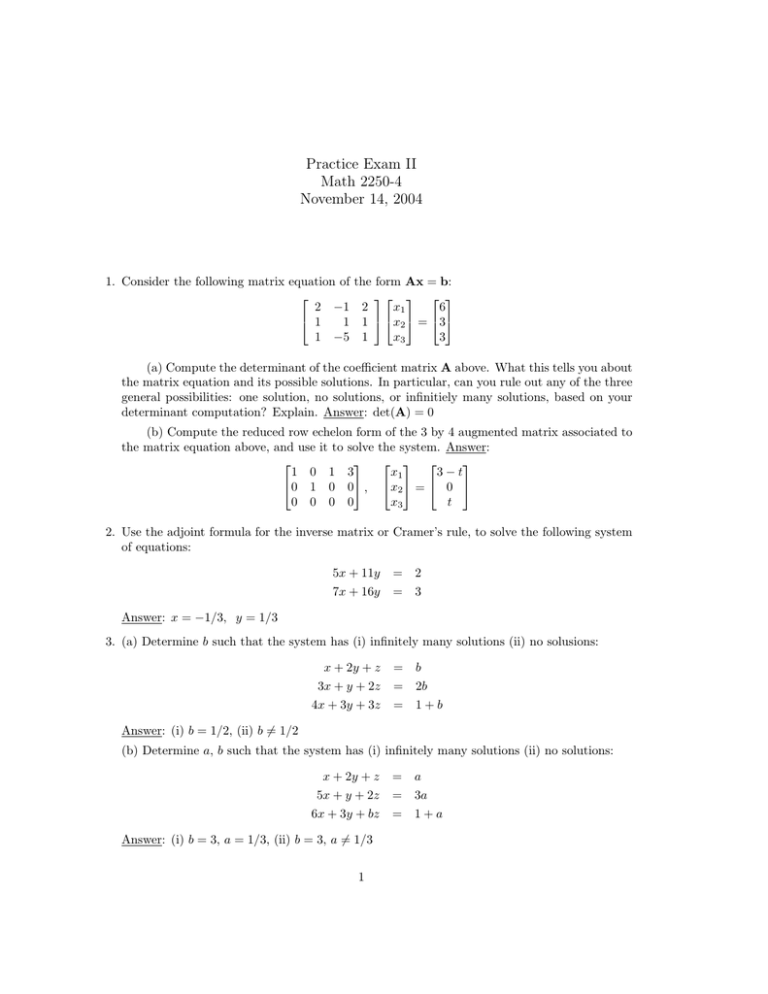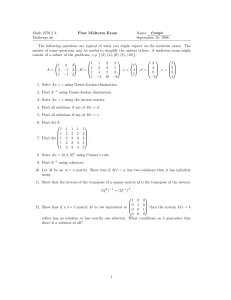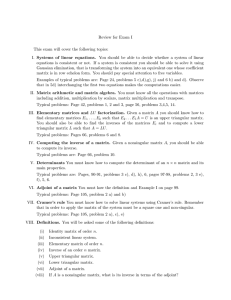Practice Exam II Math 2250-4 November 14, 2004
advertisement

Practice Exam II Math 2250-4 November 14, 2004 1. Consider the following matrix equation of 2 −1 1 1 1 −5 the form Ax = b: x1 2 6 1 x2 = 3 1 x3 3 (a) Compute the determinant of the coefficient matrix A above. What this tells you about the matrix equation and its possible solutions. In particular, can you rule out any of the three general possibilities: one solution, no solutions, or infinitiely many solutions, based on your determinant computation? Explain. Answer: det(A) = 0 (b) Compute the reduced row echelon form of the 3 by 4 augmented matrix associated to the matrix equation above, and use it to solve the system. Answer: 1 0 1 3 x1 3−t 0 1 0 0 , x2 = 0 0 0 0 0 x3 t 2. Use the adjoint formula for the inverse matrix or Cramer’s rule, to solve the following system of equations: 5x + 11y 7x + 16y = 2 = 3 Answer: x = −1/3, y = 1/3 3. (a) Determine b such that the system has (i) infinitely many solutions (ii) no solusions: x + 2y + z 3x + y + 2z 4x + 3y + 3z = b = 2b = 1+b Answer: (i) b = 1/2, (ii) b 6= 1/2 (b) Determine a, b such that the system has (i) infinitely many solutions (ii) no solutions: x + 2y + z 5x + y + 2z 6x + 3y + bz Answer: (i) b = 3, a = 1/3, (ii) b = 3, a 6= 1/3 1 = a = 3a = 1+a 1 4. Let u = −1 , 1 are dependent. 2 v = 1 , 0 1 w = 2 . State and apply a test that shows u, v, w −1 Answer: c1 u + c2 v + c3 w = 0 ⇒ det([u v w]) = 0 5. Determine all values of x for which A−1 exists: 1 2 0 A = 2 0 −3 . 0 x 1 Answer: det(A) 6= 0 ⇒ x 6= 4/3 6. Solve for y in Au = b by Cramer’s 1 2 0 A= 3 2 −2 rule: 0 2 , 1 x u = y , z 1 b = 0 . −1 Answer: [x, y, z] = [0, 1/2, 0] 7. Consider the matrix 2 0 A= 1 1 0 1 1 1 1 (a) Compute Det(A). What does this computation tell you about whether A is singular or nonsingular? Answer: det(A) = 1 (b) Find the inverse matrix to A, using the row-operation algorithm. Remember to show all work, as always. Hint: The correct inverse matrix has no fractions in it, which you could deduce from your answer to part (a). Answer: 0 1 −1 2 −1 A−1 = −1 1 −2 2 (c) Recompute the inverse, using the adjoint formula. Show the cofactor matrix as well as the adjoint matrix as intermediate steps, so that I can check your work. (d) Use the inverse matrix from 2 1 0 (b) or (c) 0 1 1 1 1 1 Answer: [x1 , x2 , x3 ] = [0, 1, 1] 2 to solve the system x1 1 x2 = 2 x3 2 8. Let A be the matrix: 1 A= 0 2 −1 0 2 1 1 1 (a) Compute the determinant of A and use it to determine whether A is singular or nonsingular. Answer: det(A) = −1 (b) Does your answer to (a) let you deduce the reduced row echelon form of A? Explain. Answer: rref(A) = I (c) Find the inverse matrix to A. Answer: −1 −1 A−1 = −2 −1 4 3 1 1 −2 9. Consider for symbols a, b the matrix 1 b 0 A = a 0 b . 0 1 1 (a) Display a determinant condition for the existence of the inverse A−1 . det(A) 6= 0 ⇒ a 6= −1, b 6= 0 Answer: (b) Find A−1 under the conditions in (a). Answer: b b −b2 1 a −1 b A−1 = b(a + 1) −a 1 ab 10. Define 2 0 A= 1 1 0 1 3 0 , 1 1 b = −1 , 0 x1 x = x2 x3 (a) Display the formulas for Cramer’s rule for the system Ax = b, without evaluating the determinants (b) Find x2 explicitly in (a). Answer: [x1 , x2 , x3 ] = [−2/5, −3/5, 3/5] (c) Display the adjoint of the matrix A. Answer: 1 3 −3 2 3 adj(A) = −1 2 −3 2 3







